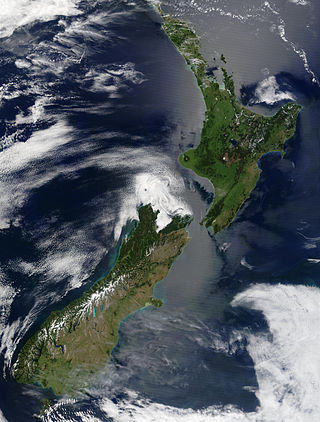
New Zealand is an island country located in the southwestern Pacific Ocean, near the centre of the water hemisphere. It consists of a large number of islands, estimated around 700, mainly remnants of a larger landmass now beneath the sea. The land masses by size are the South Island and the North Island, separated by the Cook Strait. The third-largest is Stewart Island / Rakiura, located 30 kilometres off the tip of the South Island across Foveaux Strait. Other islands are significantly smaller in area. The three largest islands stretch 1,600 kilometres across latitudes 35° to 47° south. New Zealand is the sixth-largest island country in the world, with a land size of 268,680 km2 (103,740 sq mi).

The Southern Alps are a mountain range extending along much of the length of New Zealand's South Island, reaching its greatest elevations near the range's western side. The name "Southern Alps" generally refers to the entire range, although separate names are given to many of the smaller ranges that form part of it.

Spinifex is a genus of perennial coastal plants in the grass family.

Chionochloa is a genus of tussock grass in the family Poaceae, found primarily in New Zealand with one known species in New Guinea and another on Lord Howe Island. Some of the species are referred to as snowgrass.
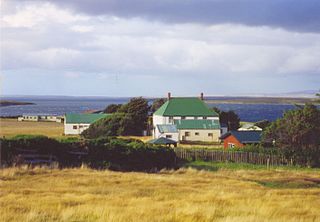
Tussock grasses or bunch grasses are a group of grass species in the family Poaceae. They usually grow as singular plants in clumps, tufts, hummocks, or bunches, rather than forming a sod or lawn, in meadows, grasslands, and prairies. As perennial plants, most species live more than one season. Tussock grasses are often found as forage in pastures and ornamental grasses in gardens.

Chionochloa rubra, known commonly as red tussock grass, is a species of tussock grass in the grass family, endemic to New Zealand.
Tussock grassland is a form of open grassland that is dominated by tussock grasses. It is common in some temperate grasslands, savannas, and shrublands ecoregions of the Southern Hemisphere. Tussock grasslands are usually typified by low rainfall and poor soils in which few plants other than hardy tussock grasses can flourish. They are predominantly populated by tufted grasses of the genera Agrostis, Andropogon, Chionochloa, Deschampsia, Festuca, Koeleria, Pentameris and Poa. The grasslands are found in New Zealand, Australia, Argentina, temperate areas of southern and eastern Africa, and some subantarctic islands.

The Canterbury–Otago tussock grasslands is an ecoregion of the South Island, New Zealand, part of the wider tussock grasslands of New Zealand.

The Southland montane grasslands, also known as the South Island montane grasslands, is a montane grasslands and shrublands ecoregion on New Zealand’s South Island. The ecoregion covers the middle portion of the Southern Alps, and includes extensive alpine grasslands, fellfields, and montane forests.
Herbfields are plant communities dominated by herbaceous plants, especially forbs and grasses. They are found where climatic conditions do not allow large woody plants to grow, such as in subantarctic and alpine tundra environments. Herbfield is defined in New South Wales (Australia) government legislation as native vegetation that predominantly does not contain an over-storey or a mid-storey and where ground cover is dominated by non-grass species. The New Zealand Department of Conservation has described herbfield vegetation as that in which the cover of herbs in the canopy is 20–100%, and in which herb cover is greater than that of any other growth form, or of bare ground.

Chionochloa flavicans is a species of plant in the grass family, endemic to New Zealand.

Argyrophenga antipodum, the common tussock or tussock ringlet, is a species of butterfly commonly found in the South Island of New Zealand.
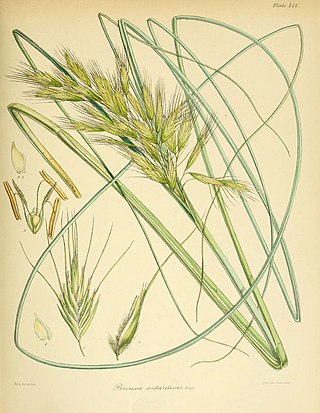
Chionochloa antarctica is a species of grass, endemic to the Auckland and Campbell Islands.

Ichneutica unica is a species of moth in the family Noctuidae. It is endemic to New Zealand and is found in the centre of the North Island and throughout the South Island. This moth is very similar in appearance to its close relatives Ichneutica phaula and Ichneutica toroneura. I. phaula can be distinguished as there is a difference in pectinations on the male antennae and I. toroneura can be distinguished as the black vein markings on the forewings is more uniform for that species in comparison to I. unica. I. unica is variable in appearance with the North Island specimens having a darker brown colour on the forewings and having a darker underside of the hindwings. This species inhabits open tussock grassland at various altitudes, coastal dunes, and inland volcanic dunes. Larvae feed on tussock grasses such as Chionochloa pallens and species in the genus Poa. Adult moths are on the wing from November to February and are attracted to both sugar and light traps.

The Ahukawakawa Swamp is an area of sphagnum bog in Egmont National Park in the Taranaki Region of New Zealand. It was formed approximately 3,500 years ago and is of particular interest to botanists. Over 260 species of higher plant have been recorded there. The area of the swamp is approximately 1 km2.
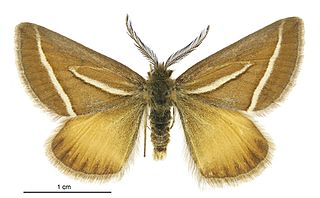
Aponotoreas insignis is a moth of the family Geometridae. It is endemic to New Zealand.

Chionochloa rigida, known commonly as narrow-leaved snow tussock and by its Māori name wī kura, is a species of tussock grass endemic to New Zealand. Two subspecies are recognised, including Chionochloa rigida rigida and Chionochloa rigida amara.
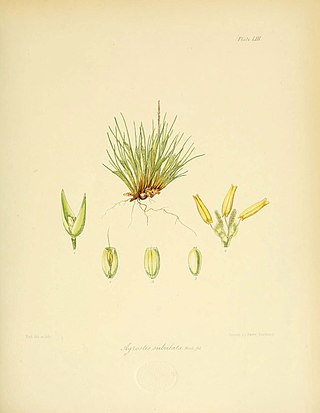
Agrostis subulata is a grass, which grows only on Campbell Island and on Antipodes Island in New Zealand.

The Southland temperate forests is a temperate broadleaf and mixed forests ecoregion on New Zealand's South Island. The natural vegetation was mostly forest, but over the centuries human activities, including grazing and fires, replaced much of the original forest with grassland and agriculture.
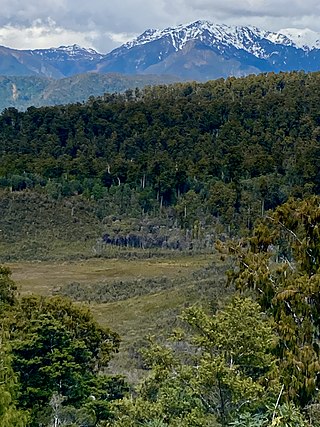
Pakihi or pākihi is a vegetation association unique to the West Coast of the South Island of New Zealand, characterised by flat boggy land with infertile, waterlogged soil on which only rushes, ferns, moss, and mānuka grow.


















